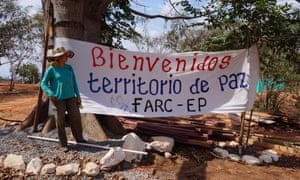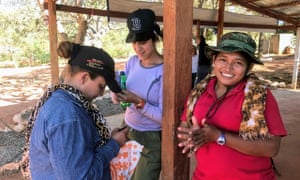The feminists of Farc: ‘We are not demobilising, we are mobilising politically’
hen she was only 20 years old, guerrilla commander Adriana left her rural home in Tolima, south of Colombia’s capital, to join the ranks of the Revolutionary Armed Forces of Colombia (Farc). “I wanted to become somebody. I wanted to do something important,” she says.
Adriana – now 38 years old, resting under the shade of a corrugated metal roof in the lush mountains of Cesar – is one of the 7,000 remaining combatants of the Farc expected to demobilise and begin a reintegration process, transitioning from Colombia’s mountains and jungles to civilian life.
For more than 50 years, the Colombian government has been at war with the Farc, a Marxist-Leninist guerrilla army – which, at its peak, claimed to have up to 20,000 members – that fought for land reforms and wealth redistribution to reduce inequality in the country, often via bloody methods. Negotiations to end the conflict began in Havana in 2012, and a peace agreement passed through Colombia’s Congress in December of last year.
Adriana says the next step is to educate Colombian society about social justice. She and her female Farc combatants, presently living in a UN-monitored demobilisation camp, say they are on a mission to empower everyday women about their rights. “We are not demobilising, we are mobilising politically,” she emphasises.
Women make up around a third of the Farc, and the presence of female combatants in the camp catches the eye of any visitor. Both men and women are involved in the construction, working to ensure that this transition area is a comfortable home for the coming months, until the group disperses to local cities and towns.
In the heat of the midday sun, they step away from their daily chores (which today include pouring cement foundations for the camp’s new housing blocks) to speak about what demobilisation means for them, and their hopes for the future. While male combatants speak of the relief at the outcome of the peace negotiations – leaving a nomadic life in the mountains, giving up their weapons, and beginning a new political project – the women reveal an unexpected agenda.
Instead of thinking of the process of demobilisation as a way of breaking up the Farc, the women in this camp plan to stay in close contact, developing what they refer to as their own brand of Farc feminism. These combatants say they have more rights than women in rural Colombian society, where female labour is neither recognised nor appreciated.
And so, they pledge to fight for Colombian women to have freedom from abuse, as well as equal access to education, equal pay, and the right to work outside of the home.
Sitting in the shade of a eucalyptus tree, Margot says that women in the Farc are far better off than those outside: “In Colombian society – look at how they kill women, look at how they rape women – they are like slaves to their husbands. Whereas here in the Farc, we do have rights.”
Margot was only 17 when she left her home in Magdalena to join the Farc: “I always wanted to be a revolutionary. In my town, there were children – little girls – without clothes, growing up in poverty, in misery. They didn’t even have enough to eat.”
The final straw came when the paramilitaries entered her town and began to kill and dismember members of the community. They burned a young boy in the town square. “That was it – I needed to join the guerrilla.”
In addition to discussions about women’s rights at camp level, the organisation has also explained its plans to advance gender equality from its central high command.
Victoria Sandino, Farc commander and co-chair of the Gender Subcommission in Havana, Cuba, is currently based at a heavily guarded hotel in Bogotá, along with other Farc leaders. Dressed in civilian garb and a colorful Afro-Colombian head wrap, she says the Farc’s primary objective is to make sure that women – combatants and victims – have the ability to move into the post-conflict era with the same rights as men. “We need to work to change the mentalities of Colombian men and to develop new masculinities. We need our men – our husbands, our companions – to be well-educated so that they recognise women’s potential, making it possible for us to adopt new roles in society.”
While the Farc’s feminist ambitions are admirable, accounts from women such as Adriana and Margot are drastically different from government and NGO reports that portray many female Farc combatants as victims of sexual violence. The United Nations and Amnesty International have recognised that sexual violence against female combatants was not uncommon. A report from the constitutional court confirms that this violence was widespread, and a 2016 investigation by the Public Prosecutor’s Office reports that there were at least 232 female combatants who were victims of various forms of sexual assault from 1979 to 2014.
For many years, it has also been reported that the Farc widely used both forced contraception and forced abortion to avoid unwanted pregnancies among its ranks. Emails between group leaders intercepted by the newspaper El Espectador in 2013 revealed that forced abortion was an institutional policy imposed on female Farc combatants, although Sandino fiercely denies this. “It is not a policy of the organisation, and we do not require women to abort. It is, however, mandatory to practice family planning. When planning fails, abortion is an option. We defend the right to abortion, and this is fundamental for us.”
Now living in Europe, far from the jungle, former presidential candidate Ingrid Betancourt (who was held by the Farc as a political prisoner from 2002-2008) says that if girls refused a commander’s advances, they were punished “every day for months … commanders would make it very difficult for them”.
When asked about this, Adriana is adamant: “I have never heard of a case of sexual violence within this block. Stories like this just try to undermine the good work that the Farc does.”
Sandino elaborates: “I am not blind to the realities of war, but I will say that much of this information is invented. Women who have abandoned the ranks are afraid that they will end up in jail unless they make up a story about sexual violence and present it to the army. Some women think they need a story like this to get benefits from the government.”
A poster hanging in the reception zone at the camp bears the message: “Peace is the most beautiful victory of them all.” The coming months will show whether this phrase will become a reality for the demobilised women of the Farc as they embark on their new project of gender equality. It is unclear if doing so, however, is necessarily contingent on silencing the experiences of those who claim to have suffered under past actions of the Farc, and whether the movement can truly change ex-combatants’ lives for the better.
- The authors are researchers in gender, armed conflict and violence in Latin America
- Source: https://www.theguardian.com/lifeandstyle/2017/mar/27/feminists-farc-colombia-female-inequality



Comments